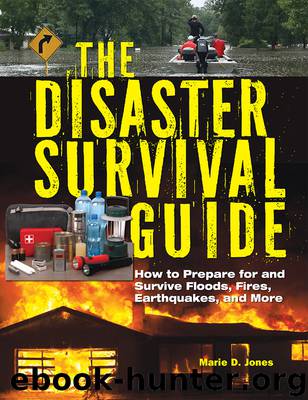The Disaster Survival Guide by Marie D. Jones

Author:Marie D. Jones
Language: eng
Format: epub
Publisher: Visible Ink Press
Published: 2018-08-08T16:00:00+00:00
Travel Safety
We spend so much time out in the world, it is important to know what to do if there is an emergency when we are far from the comforts of home. Whether we are on a road trip, taking a train across the country, flying to another country, or relaxing on a cruise ship, things can happen, and the more we are prepared in advance, the better chances we have of surviving.
AUTOMOBILES
Imagine how many people are out on the roadways on any given day or night—it is mind-boggling. Although most of our trips pass without incident, now and then there is an accident or mechanical issue that can send us into a panic if we don’t know how to react and respond.
IF YOUR CAR BREAKS DOWN
Before you hit the road, especially for longer trips, make sure your vehicle is in good operating condition by checking all fluid levels, lights, signal lights, belts, hoses, and windshield wipers.
Fill tires to the correct level as dictated in your car’s operations manual.
Have a full tank of gas.
Keep a spare tire in the rear or trunk of the vehicle.
Make sure seat belts are in good working order.
Make sure the registration and insurance information is in the glove compartment, along with a number to call for roadside service in an emergency.
If you have a breakdown and you cannot get the car running again, get the car over to the side of the road safely, and put on your hazard lights.
Call roadside service for help. Many highways and freeways have call boxes if you don’t have a cell phone. Be sure to give them as exact a location as you can.
Do not get out of the car and stand outside waiting if you are on the highway or freeway, as this is how many people are killed by passing cars. Do not assume people are paying attention!
IN A MINOR ACCIDENT
Do not leave the scene of the accident, as most state laws require you to stop. You can be charged with hit-and-run if someone you hit is injured, and even in an accident where you are not at fault.
Make sure everyone involved is fine, and move the cars off the roadway. Turn on hazard lights on both cars.
Be civil. Everyone makes mistakes.
Exchange insurance information with the other driver, and be civil.
Take photos with cell phone cameras of damage to both cars to document the damage at the time of the accident.
Download
This site does not store any files on its server. We only index and link to content provided by other sites. Please contact the content providers to delete copyright contents if any and email us, we'll remove relevant links or contents immediately.
Whiskies Galore by Ian Buxton(41544)
Introduction to Aircraft Design (Cambridge Aerospace Series) by John P. Fielding(32893)
Small Unmanned Fixed-wing Aircraft Design by Andrew J. Keane Andras Sobester James P. Scanlan & András Sóbester & James P. Scanlan(32581)
Aircraft Design of WWII: A Sketchbook by Lockheed Aircraft Corporation(32140)
Craft Beer for the Homebrewer by Michael Agnew(17940)
Turbulence by E. J. Noyes(7720)
The Complete Stick Figure Physics Tutorials by Allen Sarah(7151)
The Institute by Stephen King(6809)
Kaplan MCAT General Chemistry Review by Kaplan(6606)
The Thirst by Nesbo Jo(6452)
Bad Blood by John Carreyrou(6286)
Modelling of Convective Heat and Mass Transfer in Rotating Flows by Igor V. Shevchuk(6232)
Learning SQL by Alan Beaulieu(6045)
Weapons of Math Destruction by Cathy O'Neil(5854)
Man-made Catastrophes and Risk Information Concealment by Dmitry Chernov & Didier Sornette(5674)
Permanent Record by Edward Snowden(5550)
Digital Minimalism by Cal Newport;(5398)
Life 3.0: Being Human in the Age of Artificial Intelligence by Tegmark Max(5199)
iGen by Jean M. Twenge(5171)
